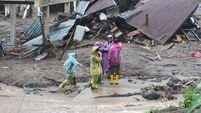Development Plan vital for health of economy
It was very ambitious, expensive but absolutely essential to the longer-term health of the economy.
The main objectives of the plan were to facilitate the pursuance of stable economic policies, invest in economic and social infrastructure and achieve a better regional distribution of public and private investment, the promotion of education and employment training policies and the enhancement of social inclusion.
All of those objectives were appropriate then and are even more appropriate today.
Unfortunately, the plan was launched when the economy was riding on the crest of the Celtic Tiger wave and there was a widely-held view that the economic momentum would be sustained indefinitely and that this momentum would continue to generate sufficient resources to easily finance the plan.
The result was that considerable resources were applied to an already very hot economy and were subsequently whittled away through inflation, particularly in the construction sector. To further the difficulties, the economy fell victim to a substantial slowdown from early in 2001 and this radically altered the economic and fiscal landscape. Public resources are now much scarcer and the delivery of some elements of the plan is under threat.
Consequently, it should come as no surprise that the mid-term NDP progress report prepared by the ESRI is sending out strong and pretty critical messages to the Government. It has been obvious to any observer over the past three years that the concept of spending control and ensuring value for taxpayers’ money has not been all that it should. Unfortunately, it is very often the case that when contractors and others realise that State money is being spent on a project, there is a tendency to milk it a bit, because there is a correct realisation that those who spend public money are less inclined to worry about how efficiently the money is being spent.
People tend to be much more conscientious if they are spending their own hard-earned resources. From the Government perspective, there has been a focus on inputs rather than outputs. In other words, the main criterion for success has been the amount of money ploughed into a project rather than the output that is produced. While this is to be expected, it is wrong and needs to change. Hopefully, the body just set up to monitor the investment programme will ensure that this is the case.
In an environment of fewer financial resources, it was always going to be the case that the ESRI assessment would spell out clearly the financial limitations going forward. However, such limitations themselves should not prevent the delivery of most elements of the plan. For example, this year the EU-favoured General Government Deficit is set to come in at around 900 million, equivalent to just 3% of GDP. This is well short of the 3% ceiling permissible in certain circumstances under the terms of the flawed Stability and Growth Pact. If the Government decided to push Ireland to the 3% limit it would release almost
3 billion extra for investment in infrastructure.
This should be attempted, because Ireland does have a strong underlying fiscal situation and has a very obvious infrastructure deficit. If such money was borrowed, it would be absolutely essential to prevent it from being swallowed up in the bottlenecks the ESRI correctly identified.
However, this is not a good enough reason not to proceed with haste. The bottlenecks can and should be sorted out. One way would be to actively pursue foreign contractors to come in and take over many elements of the project. The NDP is essential for the longer-term health of the economy and there has rarely been a better opportunity to deliver it.
















